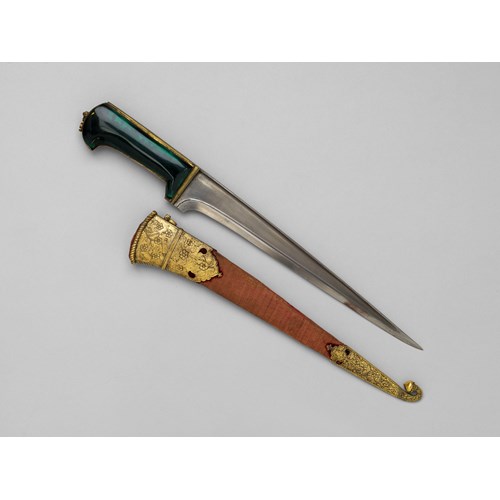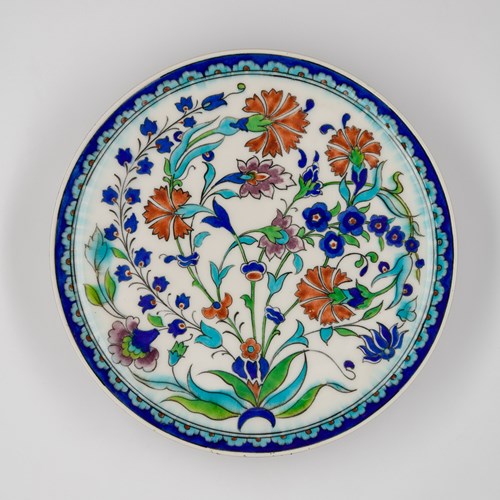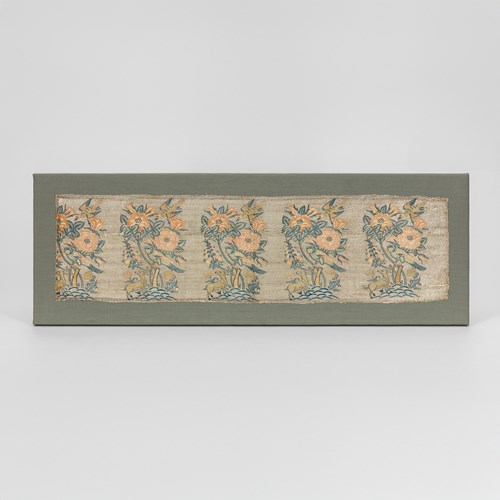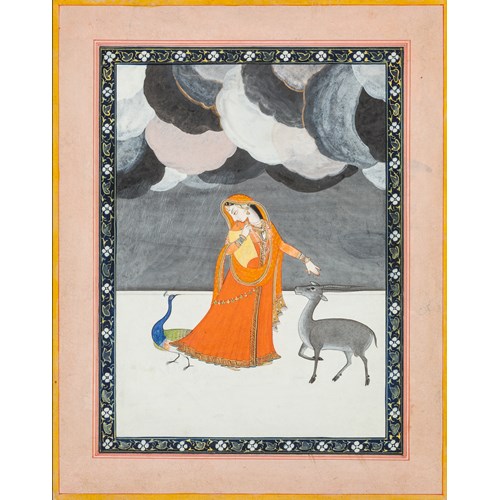A Study of a Female Crimson-Browed Finch, Carpodacus subhimachalus
Date c.1800
Epoque Early 19th century
Origine Calcutta, India
Medium watercolour on J Whatman paper
Dimension 42 x 26.5 cm (16¹/₂ x 10³/₈ inches)
Located in India, Nepal, Bhutan, China and Myanmar, crimson-browed finches appear in pairs or small groups in temperate forests and shrublands. Deriving from the Latin sub (beneath) and Hindi himachal (snow), the binomial name Corythus subhimachalus was described in 1836 by British naturalist Brian Houghton Hodgson.
Despite this not being the most audaciously coloured of the Fringillidae family, the artist of the present work demonstrates a tremendous enthusiasm for capturing the bird in an accurate and detailed manner. The feathers have been painstakingly delineated with minute brushstrokes and appear to shimmer across the bird’s back. The eye is sharp and conveys a sense of the bird’s intelligent yet wary nature. The proportions of the body also appear accurately, revealing the crimson-browed to be one of the larger finches. Given this characterful and accurate study, it would appear that the artist was not simply working from another illustration, but rather they had a true understanding of and familiarity with this particular species of bird.
Written in pencil below the bird: ‘Female? Of the Crimson Headed Finch’.
For additional ornithological studies made for Lord Valentia, see Sotheby’s Sven Ghalin Collection Lot 36 a drawing of a bustard, and Lot 37 a watercolour of a crow-pheasant, both made for Lord Valentia; Sotheby’s, London, 31 May 2011, The Stuart Cary Welch Collection, Part Two, lot 115; see also Welch 1976, no.26; Welch 1978-I, nos.18a-c.and Leach 1995, no.7.96, pp.760-2. For two bird studies donated by Viscount Valentia to Lord Wellesley, see British Library in London (Wellesley Collection, NHD 29, vol. iv, f.21,27).
Literature
Bikram Grewal et al. 2016. Birds of India - A Pictorial Field Guide. Om Books International.
Stock no.: A5494
Date: c.1800
Epoque: Early 19th century
Origine: Calcutta, India
Medium: watercolour on J Whatman paper
Dimension: 42 x 26.5 cm (16¹/₂ x 10³/₈ inches)
Provenance:
George Annesley, 2nd Earl of Mountnorris and Viscount Valentia (1769-1844), was a passionate amateur naturalist with a particular interest in ornithology. Following a career in the army, he travelled to India in 1802 where, inspired by his encounters with professional botanists and zoologists, he commissioned a number of natural history paintings.
During his four-month residency with Saadat Ali Khan, Nawab of Oudh (r. 1798-1814), the Viscount was much enthused by the ruler’s additions to his ornithological collection; “he sent people into his woods to bring me rare birds and plants; he laid a dawk two hundred miles to bring them down to me in a state of perfection.” (Viscount Valentia, 1809, p. 172.)
In 1803 he stayed with Lord Wellesley (the elder brother of the first Duke of Wellington) and visited his menagerie in Barrackpore, Calcutta. Viscount Valentia gifted Wellesley two bird studies from his collection, now in the British Library, London (see M. Archer, Natural History Drawings in the India Office Library, London, 1962, p. 96). The works bear his personal Indian seal, “The Right Honourable Lord Bahadur Viscount Valentia.”
Returning to England in 1806, the Viscount became a member of parliament and wrote a three- volume series chronicling his travels, Voyages and Travels to India, Ceylon and the Red Sea, Abyssinia and Egypt in 1802-06. Published in 1809, the books were illustrated by his draughtsman and secretary Henry Salt. Continuing his interest in the natural world, Annesley became a member of the Royal Society and subsequently his collection has become the subject of an important series of natural history studies, celebrating India’s rich ecological biodiversity.
Of the current series of paintings, four bear the Viscount’s personal Indian seal, “The Right Honourable Lord Bahadur Viscount Valentia 1217 (1802-3)”, while three others have a seal in exactly the same ink as the works with a personal seal. Considering this and that the paintings display such a great likeness to one another, it is highly probable that they were commissioned by the Viscount and undertaken by the same artists. Drawing upon Mughal traditions of exceptionally intricate detail, rich colouration and masterful observation, Viscount Valentia’s artists successfully united this with European scientific taxonomy; achieving a sense of harmony between the romantic and the rational. Charming, informative and highly decorative, these works are a valuable example of the finest early nineteenth century Indian ornithological painting.
Literature
George, Viscount Valentia, 1809. Voyages and Travels to India, Ceylon and the Red Sea, Abyssinia and Egypt in 1802-06. Volume 1, William Miller, London.
Mildred Archer, 1962. Natural History Drawings in the India Office Library, London.
Plus d'œuvres d'art de la Galerie









